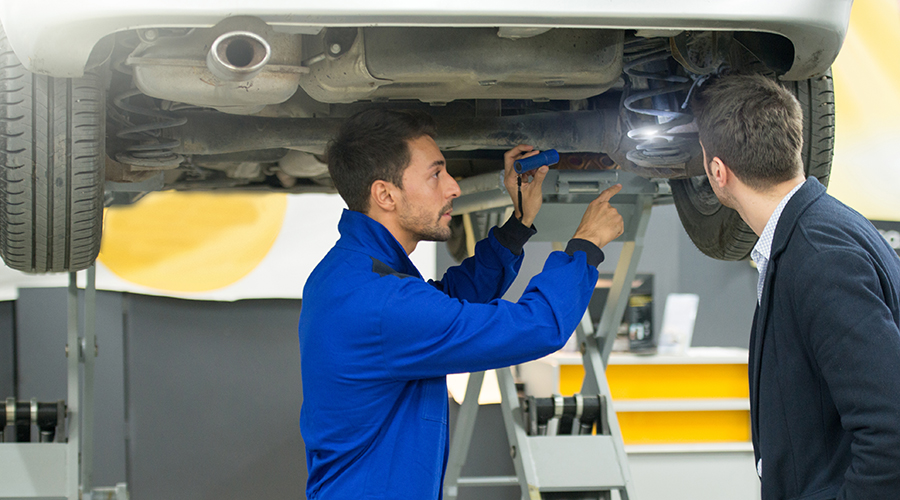Tips to help you keep repairs to a minimum
It’s a rite of spring in Edmonton as predictable as the return of the first robin. A new “bump-er” crop of potholes has once again bloomed on city roadways, much to the chagrin of local motorists.
That sinking feeling when car meets crater is sometimes difficult to avoid, even for the most attentive driver. In an average year, the city fills around half-a-million potholes in Edmonton’s streets and highways.
The freeze-thaw cycles of a long winter are often the cause. Potholes are typically created when moisture seeps into cracks in the pavement and then expands when it freezes, weakening the structure of the road surface. Temperatures warm, the water evaporates and a hole is formed – a cavity that expands with the constant aggravation of passing vehicles.
When you can’t avoid them, potholes can cause costly damage to tires and suspension systems. So what can be done? We turned to Brian Lewis (Automotive Service Technician ’00), an Automotive Service Technician instructor, for tips to keep your ride’s pothole repairs to a minimum.
Be alert
Steering clear of potholes is obviously the best way to avoid damage, says Lewis, who ran a general automotive repair shop in Edmonton for 10 years before joining NAIT.
 Try to straddle dents and cracks in the pavement; stay away from of the edge of the road where potholes hide; and watch for other drivers navigating around potholes ahead.
Try to straddle dents and cracks in the pavement; stay away from of the edge of the road where potholes hide; and watch for other drivers navigating around potholes ahead.
“Aside from just being alert visually and trying to safely dodge them there’s not a lot else you can do.”
Go easy on the brakes
When hitting a pothole, a startled motorist’s first instinct is often to slam on the brakes. But this can cause more issues, Lewis warns.
“If it looks like you’re going to hit the pothole, I’d say braking while you’re actually in the pothole is not going to help. It’s probably going to cause more damage,” he says. “The forces on the suspension are going to be greater.”
Try to slow down a bit instead. “If you’re rolling over the pothole, as opposed to trying to brake in it, the vehicle will hopefully skip over it as opposed to dipping all the way down.”
The damage done
If you do take a bone-jarring hit while driving, Lewis advises that you find a safe parking spot to do a visual inspection. Tire damage may include cracking, splitting or bulging of the tire side wall. Other common types of damage are loss of a hubcap or a bent or broken rim.
Follow up with a slow road test to listen and feel for any changes. Some damage won’t be immediately obvious, including wheels knocked out of alignment, damaged struts and other suspension components and bent steering parts.
 “For sure the most common thing I have seen is wheel bearing damage. And you might not necessarily notice the damage until a little ways down the road. What ends up happening is it makes a little dent in your wheel bearing and as it keeps wearing on that dent it gets worse and worse.”
“For sure the most common thing I have seen is wheel bearing damage. And you might not necessarily notice the damage until a little ways down the road. What ends up happening is it makes a little dent in your wheel bearing and as it keeps wearing on that dent it gets worse and worse.”
A bad bearing creates stress and strain on the wheel hub, the axle and the transmission. In catastrophic cases, when a damaged bearing fails completely, a wheel can seize up.
The most common symptom of a bad bearing is a loud noise coming from the tire or wheel of the vehicle. Lewis says it can sometimes sound like the roar of a jet engine.
“If it’s been a really severe impact where you notice your steeling wheel is off centre or something has changed then I would take it into a shop and have it inspected.”
Tire pressure is key
Some automobiles stand up better to potholes than others. Many sports cars and high-performance crossovers ride on thin, low-profile tires – a pothole’s easy victim. SUVs and pickup trucks tend to have more robust tires and sturdier suspension systems.
The best way to prevent pothole damage is to make sure your vehicle is performing at its best in the first place, with tires precisely inflated to the recommended pressure, Lewis says. Impact always starts with the tires and proper inflation provides the best cushion between broken, dipping pavement and your wheel rims.
“Just be alert when you’re driving to make sure you avoid them. And get a giant 4X4 truck,” Lewis adds, with a laugh.